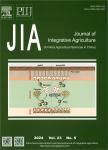Tissue distribution of deoxynivalenol in piglets following intravenous administration
Tissue distribution of deoxynivalenol in piglets following intravenous administration作者机构:College of Veterinary Medicine South China Agricultural University
出 版 物:《Journal of Integrative Agriculture》 (农业科学学报(英文版))
年 卷 期:2015年第14卷第10期
页 面:2058-2064页
核心收录:
学科分类:090603[农学-临床兽医学] 0710[理学-生物学] 0832[工学-食品科学与工程(可授工学、农学学位)] 0830[工学-环境科学与工程(可授工学、理学、农学学位)] 1004[医学-公共卫生与预防医学(可授医学、理学学位)] 0905[农学-畜牧学] 09[农学] 0906[农学-兽医学] 0901[农学-作物学] 0703[理学-化学] 0902[农学-园艺学] 0713[理学-生态学]
基 金:Financial support for this work was provided by the National Basic Research Program of China (2009CB118805) the Centre for Veterinary of Drug Residues, College of Veterinary Medicine, South China Agricultural University
主 题:deoxynivalenol,tissue distribution,immunohistochemical staining,HPLC MS/MS,swine
摘 要:Contamination of deoxynivalenol(DON) in grains is common worldwide and pigs are particularly susceptible to this mycotoxin. The distribution of DON in porcine tissues following intravenous administration was investigated in this study. Fifteen pigs were randomly divided into three groups. Animals in groups A and B were administrated with DON at the dose of 250 and 750 μg kg–1 body weight, respectively, while group C served as blank control. Plasma, bile and 27 tissues were collected at 30 min post-administration. DON concentrations in all samples were tested using high-performance liquid chromatography-tandem mass spectrometry(HPLC-MS/MS). To observe the distribution of DON in tissues, these samples were further subjected to the immunohistochemical analyses. Totally, the bile and 13 tissues were sampled for DON-based detection, including kidney, mesenteric lymph nodes, muscle, stomach, jejunum, colon, plasma, spleen, rectum, cecum, liver, ileum, and duodenum. No significant difference was observed for the concentrations of DON in duodenum, ileum and liver samples between groups A and B; while the DON concentrations in cecum and rectum of group B were significantly higher(P-value 〈0.05) than those in group A. In addition, the DON concentrations in stomach, jejunum, colon, mesenteric lymph nodes, muscle, kidney, spleen, bile, and plasma of group B were remarkably higher than those of group A(P-value〈0.01). Levels of DON in other 14 tissues including medulla oblongata, midbrain, diencephalon, pons, tip and tongue body, tongue, soft palate, tonsils, pharyngeal mucosa, oral buccal mucosa, thymus, thyroid, esophagus and adrenal gland were all below the limit of detection. The results of immunohistochemistry showed that 11 tissue samples(medullaoblongata, tonsil, adrenal medulla, thyroid gland, thyroid, stomach, duodenum, jejunum, kidney, spleen, and mesenteric lymph nodes) were positive and DON was mainly distributed around blood vessels in these tissues. Therefore, we believed that concentrations of DON in tissues differ when pigs are in exposure to various dosages and DON causes lesions in many pig tissues.



